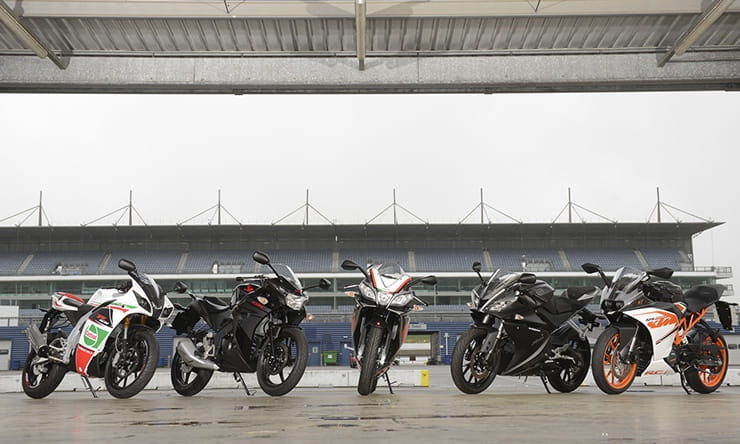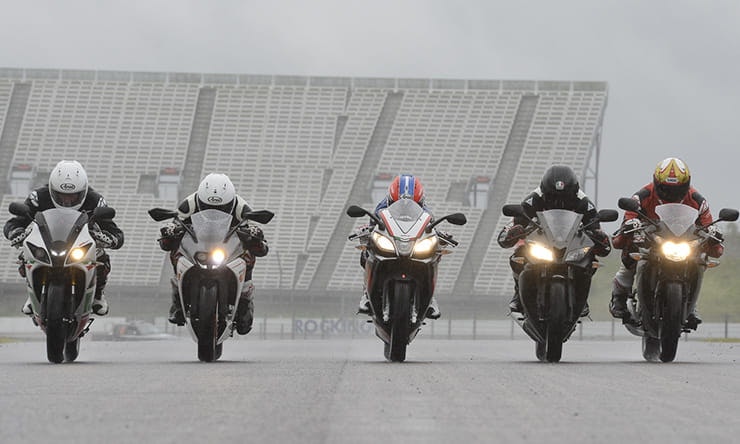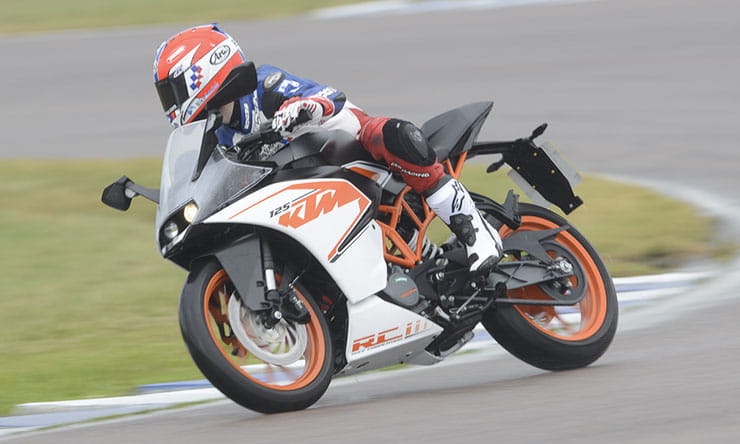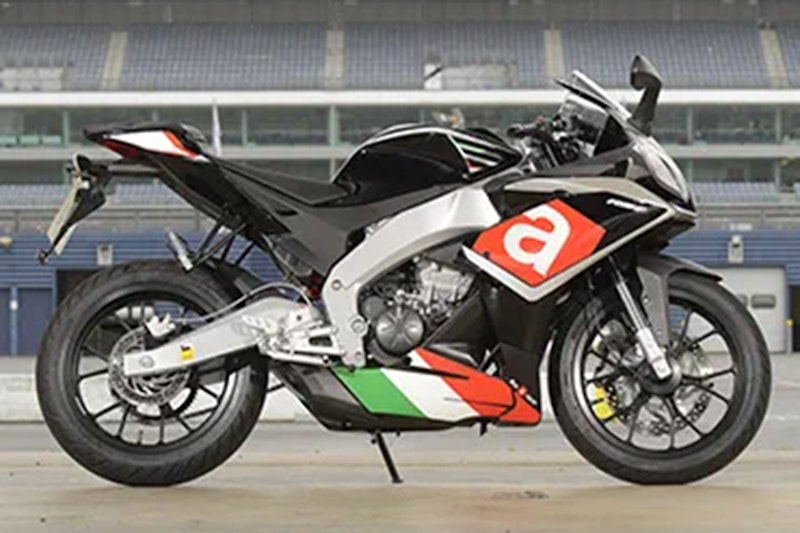Your first motorbike is a very special thing indeed. It’s a passport to freedom, the vehicle that says you’ve made it through childhood and are now a grown up. It brings independence, it brings memories. We all remember our first bike and the adventures it brought us.
But at 17, you can’t just jump on any bike. You might want the latest and greatest sports bike, but the law states that you’ll need to serve your apprenticeship on a 125cc bike that’s restricted to 15bhp until the age of 19.
Your choice is huge, from practical scooters to earnest commuters, but if the bank of mum and dad can stretch to it, there are a bunch of super-trick sports 125s out there that can easily pass for something much bigger and faster.
These mini sportsbikes have been the stuff of teenage dreams for decades, from the Yamaha RD125LC of the early-Eighties to the Aprilia RS125 and Cagiva Mito that I lusted after as a youth.
Today the choice of 125 sports bikes is as big as it’s ever been, so we decided to bring five of the best together at Rockingham circuit to put them through their paces.
As this is a five bike test, we've brought in two guest testers to join the usual Bike Social team. As well as myself, Michael and Potski we've got occasional contributor Simon 'Toad' Hancocks, who commutes every day on his KTM Duke 125, and top teenage racer Rory Skinner, who competes in the Junior Moto3 World Championship and Red Bull MotoGP Rookies Cup.
Between us, we bring a wealth of experiences and riding styles to put these little bikes through their paces. So let's meet the contenders...
Aprilia RS4 125
As the successor to the legendary RS125 two-stroke, the RS4 has a tough act to follow. That said, it looks a million dollars, every bit a miniature RSV4 superbike. At £4,071, it’s competitively priced when compared to the KTM and Yamaha. 50cc version also available.
Honda CBR125R
With a spindly steel frame and right-way-up forks, the CBR125R lacks the sex appeal of the other bikes in the test, especially in the sober black of our test bike. But it’s a Honda, with a reputation for legendary reliability and a dealership in every town. At £3799, it looks like good value too.
KTM RC 125
At £4549, the KTM is the most expensive bike in the class, but the most substantial too. It shares its chassis with the bigger RC390, giving it the feel of a full sized motorcycle instead of a ‘mere’ 125. Styling is a bit Marmite but KTM’s sporting credentials when it comes to small bikes are second to one.
Rieju RS3
At £3499, the Spanish-built Rieju (pronounced Ray-Due) is the bargain of the bunch. The Rieju brand may not be well known, but the engine comes from the well proven Yamaha YZF-R125 and the company has been around for over 80 years. 50cc variant also available.
Yamaha YZF-R125
Looking to all intents and purposes like a mini R6, the YZF-R125 has been a best seller since its introduction in 2008. Updated in 2014, when it gained ABS and sharper styling, it’s the bike the others are gunning for. At £4399, it’s not cheap, but that hasn’t harmed sales. Thanks to Alf England Motorcycles for supplying our test bike.
On the road
With almost identical 15bhp outputs and top speeds of just over 70mph, these mini sportsbikes are much of a muchness out on the daily commute.
That said, with its more upright riding position, the CBR125R comes into its own around town. Through the city streets, it is by far and away the most comfortable and easiest to ride, with the tightest turning circle and softest power delivery. It's the best machine for a novice rider and also the one that I would expect to be the cheapest to run on a day-to-day basis.
The Honda is the least powerful though, its 9.8Kw output equates to just over 13bhp - 2bhp less than the maximum allowed for 125s - but the top speed of 70mph is adequate for short stretches on the open roads.
If you spend plenty of time on the open road, the Rieju's extra top speed is going to appeal. The Spanish bike is able to squeeze out a genuine 80mph on a long stretch of road and, when you're 17, that matters. It also feels like the tallest of the five, giving it the impression of a full size bike and ideal for bigger riders.
With these, you pay your money and take your choice, so how it's as much a case of personal preference as anything else. Whichever you choose, expect fuel consumption to hover between 60-70mpg and practicality is not exactly a priority. If you want storage space, buy a scooter. With these, it's a case of packing a backpack and getting out the bungees for the big stuff. All these bikes are novice friendly and not at all scary. As a fortysomething bloke, the riding positions of some, in particular the Aprilia and Rieju would bother me as a daily rider, but I know that the 17 year old me wouldn't give two hoots about that sort of thing. Unfaired versions, such as the KTM Duke 125 and Yamaha MT-125 are undoubtedly comfier and more practical options as a daily ride and should definitely be considered by riders put off by the race replica riding positions.
Tech overview - Aprilia RS4 125
These five are mini sports bikes, brimming with technology and delivered in a package as focussed as their bigger brethren.
The RS4 is a real work of art that is easily mistaken for the RSV4 superbike, especially in the factory colourscheme of our test bike. It's powered by a new four-valve, fuel-injected single cylinder engine that's restricted to 11kw (14.75bhp) like the other bikes on test. The chassis mirrors that of the RSV4 superbike, with a alloy twin spar frame that features a beautiful swingarm and 41mm upside down forks.
Sitting on the RS4 belies it's junior roots. It feels like a proper sports bike and not much smaller than the ultra compact 1000cc RSV4 superbike. The LCD dashboard is purposeful, with a big analogue rev counter and neat little digital speed readout, while accessories include a quickshifter that allows clutchless upshifts. The alloy wheels are shod with Mitas MC25 Bogart tyres, which does feel like a rather budget way to finish off such an exquisite product.
Tech overview - Honda CBR125R
As you might expect from the world's biggest motorcycle manufacturer, Honda has a wide range of 125s in its model line-up - from the best selling PCX scooter to the laugh-a-minute MSX, commuter friendly CB125F and this, the flagship CBR125R.
At first glance, the CBR looks the most basic and dated of the quintet. Where the others look like big bikes, the Honda looks and feels like a 125 with its spindly 31mm forks, small brake discs and commuter style IRC tyres.
The engine tech is more basic too, with only two-valves in the cylinder head, and the CBR125R is the least powerful of the five, coming up just under 2bhp shy of the 15bhp quota.
Behind the cockpit you've got a familiar Honda feel with a big analogue tacho dominating a comprehensive LCD instrument pack. Overall it feels more VFR than Fireblade, with its more conservative styling and upright riding position. It's also got the lowest seat height of the five. Our test bike's black colour scheme is a conservative black with classy carbon fibre running through it, although a Marc Marquez inspired Repsol livery and traditional Honda Racing red, white and blue combo are available to give the CBR125R a more contemporary look.
Tech overview - KTM RC 125
KTM's company motto is 'Ready to Race' and it is a philosophy that runs through the core of all its products, from this entry level RC 125 to the world championship winning motocross and Moto 3 bikes.
It's no surprise, therefore, that the RC (which stands for Racing Competition) is the highest spec (and most expensive) bike on test, although of course it's ultimate power output is curbed to the EU maximum 11Kw for licensing laws.
What you've got though is a thoroughly modern twin-cam four-valve single motor that makes a meaty 12Nm of torque and a chassis that is virtually identical to the bigger RC 390 that was the fastest bike in our 300-400cc sportsbike shootout last year.
This steel trellis frame (painted orange, of course) carries chunky 43mm upside down forks and a rear monoshock (both by WP) while the brakes are from Brembo's budget brand - Bybre. It's physically bigger than the other bikes on the test, with a less extreme riding position than the Aprilia and Rieju. It's also one of two bikes on test to have ABS brakes, which is a real benefit to all riders, especially inexperienced ones.
Tech overview - Rieju RS3 125
Spanish company Rieju may be the least well-known brand of the five on test, but the RS3 has received some good reviews since its introduction three years ago.
While the styling may not be as individual as some bikes on the test, the generic sportsbike look is sharp enough and complemented by the de rigueur upside down forks (in this case 35mm Showa items) and with large Castrol logos, it's the bike that looks the most like it has just escaped from the race track.
The engine is the well proven Motori Minarelli built single overhead cam unit that appears in the Yamaha YZF-R125, although the telltale choke lever on the left handlebar provides the evidence that the Rieju drinks its petrol through a carburettor rather than the fuel injection systems employed on the other bikes.
That might be one reason why, even though it's restricted the same as the others, that the RS3 is the quickest bike of the five bikes on test, and that carb should also make derestricting and tuning the Rieju that bit easier than the others.
Quality isn't too bad but seems patchy, with the beautifully polished swingarm juxtaposed against panels that are not quite as well finished as the others. The instrumentation also feels a generation behind the others, with a tiny clock set that's not the easiest to read, but overall it's a worthy machine that probably exceeds what you might expect from the price tag.
Tech overview -Yamaha YZF-R125
Yamaha's YZF-R125 has been the recognised as the class leader since its introduction in 2008, topping the sales charts and group tests around the world.
The bike was updated two years ago, the main changes being the addition of ABS brakes, sharper styling, engine upgrades and some cool new instruments. The steel Deltabox frame echoes that of the R6, with 41mm upside down forks looking the part. Like all the bikes here, the suspension is not adjustable.
There's no doubt, in my mind at least, that the YZF-R125 is a good looking bike. I'm not usually a fan of dark colours on sports bikes, but the Matt Grey on our test bike looks very smart indeed. Where Honda's CBR125R seems to be stretching the CBR brand a step too far, the YZF-R125 feels like a perfectly credible member of the R family. It feels like a bigger bike than a 125.
It's a relatively spacious bike for a 125 and the new dashboard really is a work of art, a PS4 to the KTM's Gameboy. Tyres come from Michelin, the same as the Rieju, and overall the feel is sporty but not extreme.
Performance testing
To check the relative performance of each bike, we datalogged each machine and asked Junior World Championship rider Rory Skinner to see how quick he could make them go in a straight line.
The results saw the Rieju top the charts, taking 248 metres and 14.04 seconds to hit 60mph on a wet surface, edging out the KTM by just over a tenth of a second.
The RC 125 was a clear second ahead of the third placed Aprilia, which was handicapped by a lack of grip from the rear tyre, with the Honda and Yamaha taking up the rear.
Full results of the acceleration tests are above, with speeds in miles per hour and times in seconds.
While the wet conditions and patchy surface meant that we were unable to set ultimate lap times around the Rockingham National circuit, it was clear that what the KTM lost by the narrowest of margins under acceleration, it more than made up through the corners. The Yamaha's sweet chassis and Michelin tyres made it our second choice, ahead of the similarly-shod Rieju, with the Aprilia and Honda struggling for grip on their lower spec tyres.
Towards the end of our test day we were able to undertake brake testing on a dry surface with experienced road tester Bruce Dunn at the controls. This saw a win for the KTM, pulling up from 60mph in 3.09 seconds and 38.89 metres, with the Rieju bringing up the rear and needing two more metres to come to a standstill.
Our performance testing saw a resounding win for the RC 125, a narrow runner-up under acceleration but best under braking and fastest around the track.
The Yamaha, while not outstanding in the performance tests, gave a good account of itself on the track thanks to its sweet chassis and tyres that coped better with the conditions than those fitted to the Aprilia and Honda.
The Rieju, while the fastest in a straight line, was generally regarded to have the weakest chassis, although it comes with the same Michelin Pilot Street rubber as the YZF-R125, giving it an advantage in the wet conditions.
Tyres were the major factor in holding the Aprilia back on the track, especially in the wet, while the Honda was an accomplished enough all-rounder but also struggled on the wet track.
So what are they like in the wet, mister?
Typical. It was gorgeous for a fortnight before, and glorious for the week after, but for the day of our photo shoot it rained and rained and rained.
As usual, the manufacturers had provided the bikes on loan, meaning that we had an opportunity to see what they were like on the daily commute but for the day we had booked for our photo shoot, and to performance test them with Rory, at Rockingham circuit we enjoyed nothing but grey, miserable wetness. Ah well...
While the rain took out a lot of the fun of the test and would prohibit us from seeing how quickly they could go around the track, it did provide us with a real world situation.
Unlike many sportsbikes, which are wheeled out for sunny Sunday afternoon ride outs, 125s are usually their owner's sole transport and ridden in all weathers. Rockingham is pretty treacherous in the wet but so too is my local roundabout, so understanding how the bike will ride in the rain is pretty fundamental for any British rider.
Understandably how they rode came down as much to the tyres fitted to the bikes as the chassis themselves. Small bikes traditionally have budget tyres fitted to them and these were to prove the limiting factor in taking the bikes around the wet circuit.
The combination of hard compounds, low power and minimal weight meant that getting heat into the tyres proved futile, even though the ambient temperature was in the 20s.
Worst affected was the Aprilia, which literally snapped sideways when Rory dropped the clutch for an acceleration run. Even going gingerly around corners, the back end wanted to step out under the slightest throttle opening, something that shouldn’t be happening with 15bhp at the back wheel. It certainly gave me a surprise and led to Potski coming in after a lap and declaring that there was ‘something wrong’ at the back. It’s a real shame, but if I was running an RS4 as my daily ride I’d be dumping those stock Mitas tyres (or Savas, as they used to be known) and spending £200 on a set of premium branded tyres like Pirelli Rosso 2s, it’s the best insurance policy you can buy.
The Honda too is afflicted by budget tyres, albeit not as terrifying as those on the Aprilia. What the OEM IRCs lack in grip they at least make up for in predictability. Push on and the front tyre gives plenty of warning that it’s had enough but, as with all the bikes, there’s little in the way of lean angle to be had in wet conditions. The CBR125R’s real world manners does make it the nicest to ride in the wet though, the higher bars and more upright riding position making it the most comfortable to ride at a steady pace.
Both Rieju and Yamaha have fitted higher-spec Michelin Pilot Streets to their sports 125s. Although not designed for ultimate grip, they provide a good degree more feel than the rubber fitted to the Aprilia and Honda, and that showed in the track sessions. The Rieju’s chassis feels less precise than that of the Yamaha on track, but it is the KTM that is the benchmark for the class on the circuit. Where the others feel skittish, the RC 125 feels planted. The unbranded tyres may not have the kudos of the Michelins, but they work perfectly well and are never stressed by the 15bhp going through the back wheel. We felt that it was better for ourselves (in other words safer) not to time the laps in the wet, but the way in which the KTM rode around the outside of everything else was proof of its superiority. With wider tyres and a more generous riding position, it feels like a bigger bike than a 125, and that’s got to be a good thing, right?
Guest testers' video verdict
To give a different perspective to the test, Bike Social invited two guest testers with very different backgrounds to join the team at Rockingham.
Simon 'Toad' Hancocks is a KTM Duke 125 owner, who rides day-in, day-out in his commute to work as a referrals specialist for a leading motorcycle insurance specialist.
Joining him is Rory Skinner who, at 14-years-old, is Britain's brightest racing prospect. The former Aprilia Superteen Champion, from Perth in Scotland, is Britain's sole representative in both the Junior Moto3 World Championship and Red Bull MotoGP Rookies Cup, where he races 50+bhp Moto3 bikes.
As well as taking their comments into consideration for our overall verdict, we asked them to give their thoughts on each bike on camera.
Verdict
The Honda is playing a different game to the others. It’s cheaper than the models from the other established players and the one that you should buy with your head, if not your heart. It’s certainly not as sexy or exciting as the others, but it’s an earnest entry level bike that brings with it all that’s good about Honda. You could do a lot worse than buy a CBR125R and if we were judging this test on other criteria, it’s a bike that could come out on top. It’s not the ultimate L-plate machine though.
That accolade could have gone to the Aprilia. If looks and heritage won awards, this test would have been over before a wheel had even been turned. The two-stroke RS125 was a tough act to follow and the RS4 certainly comes close with its gorgeous looks, high spec and lively engine, but when the wheels did turn the Aprilia didn’t quite have the go to match the show. This might well be the best bike of the bunch, but it’s handicapped by the worst rubber and this was massively exposed in the slippery conditions. I’d love to ride one of these on some decent rubber, because I really believe that those dire Mitas stopped it from fulfilling its full potential during our test.
Pound-for-pound, there’s nothing that can touch the Rieju. It’s the bike that we had the lowest expectations of, but the reality is that it can hold its own in the class and not just as the plucky underdog. The engine is really strong and smooth and the styling tidy, if not cutting edge. The chassis does feel a touch vague compared to some of the others but at over £1000 less than the KTM its an absolute bargain. What it doesn’t have is the name on the tank or the big dealer network. That might be reflected when it comes to resale time, or in getting a bargain PCP or insurance deal, but on paper it’s a hell of a lot of bike for the money.
But the battle to be the ultimate L-plated sportsbike comes down to a straight fight between the two most expensive bikes on test, the KTM and Yamaha. This is where things get a bit awkward.
Personally, I'd buy the Yamaha. It looks superb and although it may not be the strongest in any one single area, it’s so well rounded and accomplished that it gets my vote as the better day to day ride. It is well equipped and has a real quality and grown up feel about it, from the modern and comprehensive dashboard through to the lovely build quality. It also benefits from a bigger dealer network and arguably has the best badge on the tank.
But on this occasion I have to give in to my colleagues. I find it hard to love a bike that has taken as severe a beating from the ugly stick as the RC 125, but we're unanimous in declaring it the best to ride. It's the fastest around the track and feels like the biggest of the five bikes on the test. It may be the most expensive, but it's the highest specced and most accomplished too. If you're 17 and looking for the ultimate bike to ride on L plates, the KTM RC 125 is the one for you.
Thanks to Rockingham for their hospitality (if not the weather), Rich Beech for the video and Mark 'Weeble' Manning for the photography.
Big thanks too go to Rory and Toad for taking time out to join us as guest testers, and to Alf England Motorcycles for providing the YZF-R125 at short notice. Gentlemen one and all!



